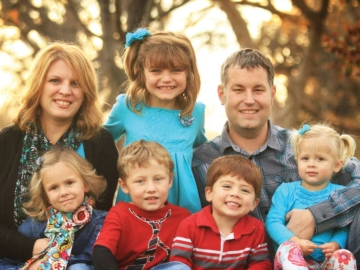
For active love is a harsh and fearful thing compared to love in dreams. Love in dreams thirsts for immediate action, quickly performed, and with everyone looking on. Whereas active love is labor and perseverance, and for some people, perhaps, a whole science.
Fyodor Dostoevsky, The Brothers Karamazov
These words have haunted me ever since I first read them as a first-year student at Messiah College, a BIC-affiliated school in Mechanicsburg, PA. I recognized myself in Dostoevsky’s description of dream love; I still do. But I also yearn for something better. I am conscious of being called by God to the harsh, fearful, and utterly beautiful reality of active love — the love Jesus showed us on the cross — and this passage has served as a reminder of his calling in my life.
Dostoevsky’s words were also among those echoing in my heart when I accepted the call, following three years of seminary in privileged Princeton, N.J., to plant a new congregation in an impoverished neighborhood of Dayton, Ohio. Anyone who is foolish enough to move from a place like Princeton to a neighborhood full of poverty and crime is likely to need such reminders. I am tempted every day in this difficult context to substitute dream love for the real thing. I still lust for dramatic, noble-seeming actions that would issue quick results and easy answers for the hurting and broken people around me.
Dream love, however, can heal no one and solve nothing. It is a counterfeit — an empty copy of Jesus’ love, which always expresses itself on a cross.
It was that love that took me from Princeton to East Dayton. And that love, I’m discovering, is no discrete commitment. It has no limits and sets no boundaries. It carries obligations and costs that cannot be measured in advance. It continues to give in the absence of reciprocation. It surrenders every demand for control and accepts into itself the pain of uncertainty. It is, above all else, patient.
Every other attribute of love — its kindness, its selflessness — can be temporarily imitated. But only Jesus’ love has the ability, day after day, over many years, to love an unloveable person quietly and without thanks or recognition.
I prayed the name of Jesus over her, offering nothing but his love. What a foolish thought — love only. The love of Christ works miracles every day!
I’ve only lived in this neighborhood for a little over two years, and yet that has been long enough for me to discover my lack of patience and poverty in love. But here is the good news: Though my love is pale and dreamlike most days, the inexhaustible love of God, made visible in Jesus, still stands and shines with the radiance of a thousand suns over my life. It shines over my little church and this hurting neighborhood, warmly illuminating everything. His love calls me forward, promising to recreate itself in me and, through me, to recreate itself in others.
It caught hold, one night, of a weeping heroin addict whom I held in my arms after she crumpled in despair onto the sidewalk outside my house. I felt inadequate and at a loss. I had nothing to give her, I thought, and no way to help her. I prayed the name of Jesus over her, offering nothing but his love. What a foolish though — love only. The love of Christ works miracles every day! It has, does, and will always suffice.
That same woman has been free of drugs for over a year now, is on the honor roll as a full-time college student, and is nearly ready to regain custody of her daughter — all thanks to the active, inexorable, unbreakable, fearsome, and holy love of Jesus Christ. She still struggles every day, but the love of Christ struggles with her, strong enough to tame her chaos and heal her wounds if she will only keep submitting to its awesome power.
Jesus’ love is a summons to die and the gift of life. It cannot be the latter without also being the former. By God’s grace, I will continue to die into and live through his love until, one day, I wake up in a world made new by its power.
Adapted from “Calling: Stories of everyday people loving God & neighbor in extraordinary ways,” an article for the Winter 2014 issue of BIC U.S.’ In Part magazine.



